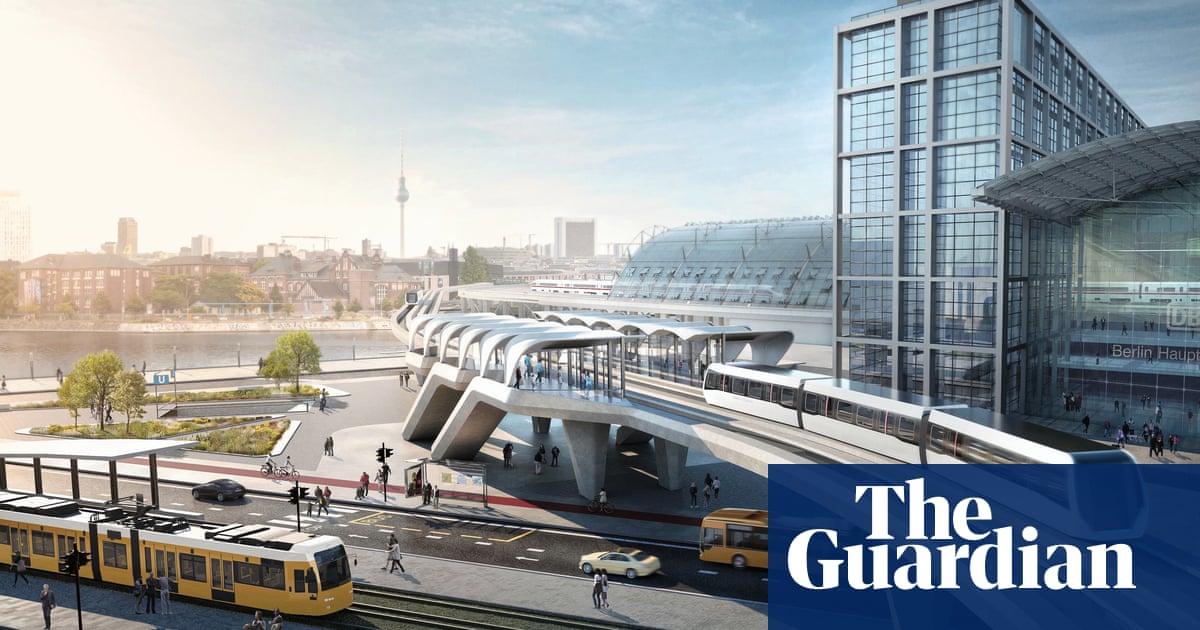Nobody needs driverless or magnetic. Just do the simple fucking trains for now. Bunch of circus baboons the lot…
Driverless transport is a huge boon to a transit system.
If they didn’t advertise it and kept it lowkey nobody would have complained…
Driverless is fine, but what’s the maglev for? It’s a tech that sounds futuristic, but solves no problem and causes a bunch of new ones.
Speed. High speed trains clock in at 300 km/h, whereas maglev takes you to 600 km/h.
I agree with the above commenter, the EU needs to streamline passenger rights and international connections first, like they did for airtravel, but once that is taken care of, the next step is connecting European capitals on high speed maglev with very few stops.
To give you a sense of what such a transportation system could achieve, you could go from Lisbon to Kiev in 6 hours and a half at 600 km/h. If capitals served as country maglev hubs, we could do away with intra European flights altogether and cut a significant amount of flights to outside of Europe by concentrating the departures.
You could then have a hierarchy of sorts where maglev serves traveling between capitals, high speed between major cities within countries, regional between regions of smaller sparsely populated towns and local trains within cities or between close cities. Ideally if a passenger wanted to travel from a small town into another small town 3000 km away, the service should book all the appropriate hierarchy changes in one ticket.
The issue is that the line would have to be pretty much straight or have very shallow curves, due to the speed, so it would take a TON of land buying. That’s complicated enough as it is without even considering the NIMBYs.
The line that is proposed in Berlin is less then 10km long. If speed is the great upside of maglev then it can’t even play out this strength here.
Oh yeah no issues from me there. I was answering the original question of what maglev tech is for. Maglev only makes sense for very long distances.
This is intracity travel. There isn’t enough distance for high speed lines to make sense.
Speed. High speed trains clock in at 300 km/h, whereas maglev takes you to 600 km/h.
which would be great but the end point is only 6km away - you’ll spend the entire trip accelerating and then decelerating.
You could even split it into different tiers, depending on demand and system load. If tons of people are going between, let’s say, Zurich and Madrid, they could just run a dedicated service straight through. On the flip side, a “limited express” that makes stops at national border stations and capitals would decrease the necessity of backtracking as much (e.g. Berlin to Poznań).
I’d imagine maybe larger countries would have more than one stop, but the issue is every time the maglev makes a stop it needs to slow down and speed up again and that adds up over time. I think that’s a big issue with high speed trains nowadays in certain regions. The train is at maximum allowed speed by infrastructure about 40% of the time because it stops too often.
It would be a shame if it became impractical due to being too slow so people would take the plane instead. If you look at the Japanese Shinkansen stops are very well spaced, for instance, Tokio-Nagoya or Osaka-Hiroshima with no stops in betwen. That’s 350 ish km with no stops.
That’s why I was discussing having different service levels that stop at different frequencies - direct (high-load city-to-city with no stops), express (between capital/core cities), and limited express (capital/core + border stations, perhaps just serviced with existing high-speed non-maglev lines)
what’s the maglev for?
Speed.
No, it will run at up to 150 km/h. Not inter-, but intra-city.
This article mentions it would be easier and cheaper to build new maglev tracks compared to traditional rails, because it needs no catenary, and can be put on stilts.
Fucking magnets , how do they work ?
Seriously though what is maglev ?
Driverless is pretty good as far as trains are concerned. It’s already figured out in some systems, so it’s not unproven technology as is the case in cars.
Driverless is fine, it’s the magnetic thing that has me raising an eyebrow.
There’s plenty of systems that would fall apart without driverless as their train frequencies are so high manual operation is not an option. Under less extreme circumstances it’s still a good idea because it allows you to use more small trains instead of fewer larger trains, saving space (smaller stations), operating costs (drivers tend to want to be paid), and increasing frequency which is mindbogglingly important in public transit.
As to magnetic: This system in particular is very good, better than standard rail, at elevated track because it can be built lighter because the train doesn’t produce point-loads (in the form of wheel contact), but forces that are easier to direct into the ground. It’s also quieter.
This is not a high-speed system, 150km/h is the current max and IIRC they said the tech can’t possibly ever do more than 200km/h. We’re not talking about building a Shinkansen or Transrapid, but something metro-scaled, both in capability and cost.
Copenhagen has driverless in their subway system. Works great.
Yeah, I think trains are awesome but what’s the justification for maglev here? Why get a whole other set of trains, maintenance equipment that is incompatible with other systems in the city?
Looks like it is a 6 mile line that will demonstrate whether maglev is practical
Surely they can’t just go to Japan and find out it’s very expensive and not really worth it compared to just building traditional trains. They must first waste trillions on it themselves.
Parade pony projects should be banned from public transport already.
Sure, there are better ways to spend the money, but there are much worse ways also.
The way that spending like this comes back to bite us is when anti-public transport lobbies use this as a poster child for why trains won’t work instead of for why maglev doesn’t work.
i would build a national porn studio the size of an airport
Completely different systems for completely different applications. Japan is building over-regional high-speed rail, this is about a metro-scale application with passive tracks.
if you’ve been to berlin you would know that they could use a few more
The term is: https://en.wikipedia.org/wiki/Gadgetbahn
Gadgetbahn is a neologism that refers to a public transport concept or implementation that is touted by its developers and supporters as futuristic or innovative, but in practice is less feasible, reliable, and more expensive than traditional modes such as buses, trams and trains. It is a portmanteau of the English word “gadget” and the German word Bahn, meaning “train” or “railway”.[2][3]
makes me wonder what they call Monorails…
Monorails are often considered a gadgetbahn.
Gadgetbahn is less about being new, and more about being gimmicky with few real advantages.
No, it really isn’t. TSB has actual advantages. In a sense it’s roughly Transrapid technology scaled down to ~150km/h, city and regional operation. IIRC they said the tech scales to max. 200km/h.
One advantage is how cheap elevated ways are with the thing: Ordinary train wheels are point loads which need quite sturdy reinforcement to properly distribute the forces. Of course that won’t matter if you build the thing on the ground or dig tunnels.
Also Berlin’s old maglev was quite successful (given the circumstances) and beloved. The reason it didn’t survive is because it was made redundant when east and west subway infrastructure was connected up again after reunification, the track was simply in the wrong place.
Another only apparent Gadgetbahn is Wuppertal’s hanging monorail: It makes perfect sense in Wuppertal – and probably also only there. It’s a very narrow valley and over long stretches the only sensible place to build rail public transit was over the river.
Thanks for your nuanced contrapoints in this thread. I cannot judge wether it’s true, but I appreciate a different perspective.
We allready had the M-Bahn in 1990. https://en.m.wikipedia.org/wiki/M-Bahn
At this time it would have been new and modern…
Trains are still better than cars, so id rather have one AI maglev train than a bunch of cars on the road
Would you like 1 maglev train for 10km, or 10 extra trains to make better use of existing infrastructure?
The problem is that with that kind of budget you could improve a lot more traditional trains
It’s really just hyperloop 2.0 in order to not improve the classic public transportation
Except maglev is a little more than a tech demo and not at all ready for use.
Normal high speed train is way better
Japan is in the middle of building a very long maglev line, what about it is supposed to be not at all ready?
There’s still no point for a 10km intracity line, but for important long distance routes it seems like the best way to kill flights, though we’ll see how it works out for japan whenever they finish it.
It’s been testing for how many years? And they still don’t have a end on sight
Because they can’t (couldn’t?) build it for the usual reasons that there’s one place on the route where they have trouble getting permission. Not because of any faults with the technology.
Also wasn’t even the original planned completion date still in the future? You don’t build hundreds of km of railway featuring some of the longest railway tunnels ever built in a year.
What do you mean not ready for use? Its existed for decades
how about actual public transport, like being able to laterally move outside of cities, not being hilariously late every time and paying your workers enough, not resulting in endless strikes?
The use of astroturfers to sway or argue on social media sites, like Reddit :P, has me playing minesweeper with this comment section lol. Who is genuine and who is paid to push for a certain position?
Could please you explain what you mean?
He thinks some people on here are bots/shills. If he doesn’t agree with their comment he blocks/flags them.
Thanks
Guessing which accounts are real or not, and being careful with who I upvote.
I mean, I didn’t think he was clear and wanted them to clarify. I’m a real person doing things that people do like asking questions, replying to comments, and vomit white biofluid when people get too nosey.
It would just save emissions not money. Is Berlin afraid to invest in any big projects with a bit of risk, because they’re still traumatized by the airport debacle, that took about a decade more to finish?! Correct me if you’re ein Berliner. Taking a bit longer is normal in big infrastructure projects but years is something different.
No, I think the conservative party is just too scared to touch cars.
They rolled back quite a few projects to improve cycling infrastructure, citing it’s negative impact on car traffic. They’d rather see a continuation of the traffic collapse than be the ones who start all the construction and draw the wrath of car brains on them.
So to appease the people who do want more public transport, and environmentally conscious traffic, they propose some “look it’s futuristic” new tech miracle solution while funneling research funds to their business buddies and thumping their patriotic chests for found something for German industry.
Because building a tram is not prestigious enough (and conflicts with the holy car).
This is the best summary I could come up with:
Plans for a driverless magnetic train that would swoop through Berlin and carry passengers and goods are under way as part of the local government’s attempts to boost the German capital’s green credentials.
At a time when Berlin’s transport company, the BVG, is so short of drivers that it has reduced its timetable by about 7%, Stettner said the fact that the train was self-driving as well as cheaper and easier to construct than an underground line was a further advantage.
It was dismantled in 1991, two years after the fall of the Berlin Wall, to allow for the restoration of the U2 underground line, which had been cauterised by the erection of the notorious cold war barrier that cut the city in two.
At a recent presentation of his plans, including slick architectural sketches, Stettner said there were many ideas on how to practically make use of a new M-Bahn in a city that retained the scars of division.
Last month Germany’s highest court blocked the federal government’s plan to shift leftover Covid-era aid to fund projects to tackle the climate emergency, leaving many policy decisions in limbo.
“If the funds survive the court’s earthquake decision, they should be used to finance efficient ways to reduce CO2 emissions, and to adapt to climate change, not for willy-nilly ‘perhaps nice-to-haves’,” it wrote in an editorial.
The original article contains 834 words, the summary contains 225 words. Saved 73%. I’m a bot and I’m open source!
This is just another useless pet project some dumb politician is trying to introduce to gather votes from people that won’t have to take this train anyway. I’d rather they fix current infrastructure and expand it as it is instead of throwing money at hyperloops, inner city maglevs, ad other dumb pet projects.
So it’s the 1984 HyperLoop?
“High tech” shit that doesn’t solve transport issues.
Maglev trains don’t solve transport issues?
If it takes money away from more practical transport projects that can have more impact, they kinda are not solving the issue.
They are a needless complication. You’re not going to go that fast for intracity transport, and high speed intercity trains are getting along fine without it, anyway. It takes more power, complicates rail switching, and you can’t have a third rail for providing direct electricity.
Nothing wrong with traditional rail. Maglev is cool on paper, but solves no actual problem.
Maglevs are generally advertised as being city to city transport.
They do have a higher power consumption than bullet trains at high speed (the LO uses about 90-100 kw/seat - km vs the N700 series which is 70 kw/seat-km), however they are going up against air travel which is far less efficient (Airbus A319neo uses ~209 Wh/seat-km). So compared to flying they are still way more efficient. I’m not sure about the rail switching, it looks like they have fewer moving parts but I haven’t looked into it. I’m not sure my having a third rail is that important? There are other methods of providing power to trains for example using pantograph or induction or by recovered harmonic oscillation of the magnetic fields created from the track.
Maglevs reduce travel time, better acceleration, better incline performance, lower maintenance costs, are quieter than conventional rail, can operate at higher speeds during rain or snow since the don’t rely on friction for breaking, and are still more efficient than air travel. However, running costs (mostly from power consumption) are more expensive and they can’t use existing infrastructure. So on paper they solve many issues while having fewer cons than conventional high-speed rail.
Switching is a big, complicated mess for maglevs. Traditional rail is simple here, and has been solved for over a century.
Maglev could be good for city to city, provided those cities are far enough apart and you make no stops in between. Problem is, we often want to give service to cities in between. Forcing maglevs to accelerate and decelerate all the time kills their advantage.
How is it a complicated mess? They’ve had track switching for at least 30 years and in many cases use a similar method to what monorails use. Is there something I’m missing here?
How does having stops for cities in-between kill their advantage? They still have faster acceleration and deceleration and higher speed overall, and the low number of moving parts will mean less wear and tear during the constant stopping and starting. The Chuo Shinkansen line is planned have nine stops along its route.
The only issues I see this having are the energy costs and whether not people will see the higher ticket prices to be with it for lower travel times since the line in China isn’t competing with the existing cheaper high speed line for those very reasons. But then again the Chinese maglev only runs between the airport and a stop that’s not even in the city centre.
It solves the problem of long travel times if you’re not flying. Not in this case of course, but in general. Even a straight line HSR line from e.g. Hamburg to Munich could never compete with a plane. Maglev could.
There are plenty of caveats in the additional requirements for higher speed trains, but there is a reap problem to be solved.
That normal trains don’t?
A driverless Maglev train is already rideable in Japan.
https://m.youtube.com/watch?v=4ZX9T0kWb4Y&pp=ygURQ2jFq8WNIFNoaW5rYW5zZW4%3D
Whether or not it’s worth it is yet to be determined. Driverless trains of lower speeds also already exist.
https://en.m.wikipedia.org/wiki/List_of_driverless_train_systems
I’m not sold on “driverless”. Even if it’s being monitored 24/7 by some dude in Brussels or whatever, there’s really no substitute for having someone PHYISCALLY on that train, in control, in case of an emergency or something.
There’s been driverless subway for decades though, if it’s intracity travel (which seems the case here), then it makes sense.
Maglev doesn’t, as many pointed out
Someone will have to be there still, but they can do more useful things than sit in a box staring at signals
I never said they don’t exist. It’s old technology.
For the price of a ridiculous project like this how much conventional PT could be built by a workforce that already is equipped for it.
It does and it doesn’t. The problem I’ve seen with all these new transportation products is the goal to create a “new industry” with it so that the tech can be sold elsewhere in a competitive market.
The problem is that elsewhere is often the USA … and the US doesn’t buy public transportation tech from foreign entities.
Quebec buys their trains from France, many nations but their highspeed trail from Japan and China. (I think a few places actually bought a monorail from Disney). It’s a high cost to get into an industry like public transportation at this stage of the game unless you bring something new to the table.
It does because it’s a national jobs program and offers a boost to the local economy, it doesn’t because in the end it is wasteful, impractical, and eventually too expensive for the taxpayer to maintain.
Why can’t we ever have anything cool?
Why is the guardian doing such a shitty headline?
deleted by creator
no democratic country can build a new train. it will never happen again. better add some new gastric highway bypass instead.










